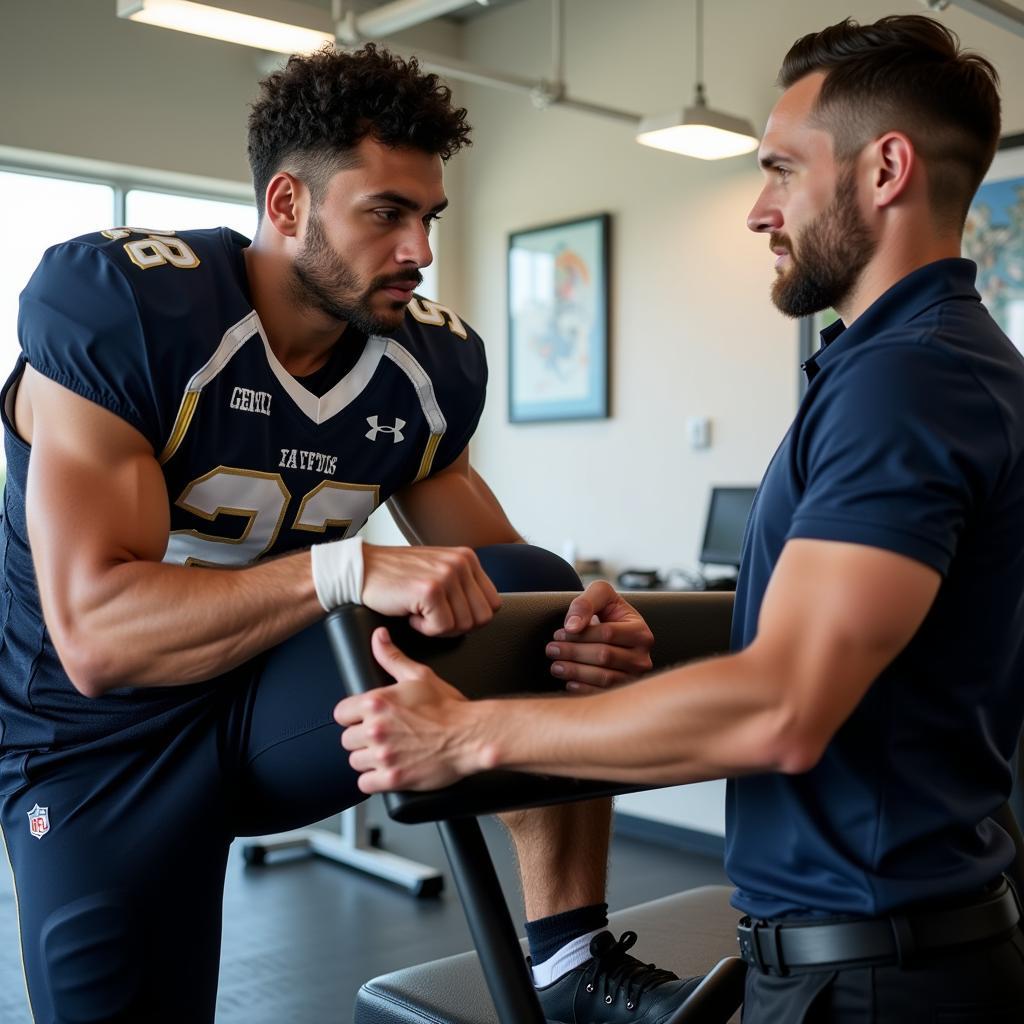Football Player Torn ACL: What Does It Mean?
October 26, 2024A torn ACL is one of the most feared injuries in football. It can sideline a player for months, and even after surgery and rehabilitation, there’s no guarantee they’ll ever return to their previous level of play. Unfortunately, for football players, a torn ACL is a reality that many face during their careers.
Understanding ACL Injuries in Football
The anterior cruciate ligament (ACL) is a major ligament in the knee that connects the femur (thigh bone) to the tibia (shin bone). It provides stability to the knee joint, particularly during twisting and pivoting movements, which are very common in football.
Football players are particularly susceptible to ACL tears due to the nature of the sport. The high-impact tackles, rapid changes in direction, and forceful landings can all put significant stress on the ACL.
Common Causes of a Torn ACL in Football Players
- Sudden stops and changes in direction: These movements can cause the knee to twist, putting excessive force on the ACL.
- Landing awkwardly from a jump: When a player lands from a header or a jump with their knee twisted or bent inward, the ACL is at risk.
- Direct impact to the knee: A tackle from the side, for example, can directly hit the knee and tear the ACL.
Symptoms of a Torn ACL in Football Players
- A loud “popping” sound at the time of injury.
- Intense pain, often making it difficult to bear weight on the affected leg.
- Rapid swelling around the knee joint.
- A feeling of instability in the knee, like it might “give way.”
How is a Torn ACL Diagnosed?
If a football player experiences any of the symptoms mentioned above after a knee injury, immediate medical attention is crucial. A doctor will conduct a physical exam, assess the range of motion, and may order imaging tests, such as an MRI, to confirm the diagnosis and determine the severity of the tear.
Treatment Options for Football Players with Torn ACLs
The treatment approach for a torn ACL in a football player depends on several factors, including the severity of the tear, the player’s age, activity level, and future goals.
1. Non-Surgical Options:
For partial ACL tears or in cases where surgery isn’t the best option, non-surgical treatment may be recommended. This typically involves:
- Rest, Ice, Compression, Elevation (RICE): This helps to reduce pain and swelling immediately after the injury.
- Physical Therapy: A structured program focuses on strengthening the muscles surrounding the knee to improve stability and range of motion.
- Bracing: A knee brace can provide support and stability to the joint as it heals.
2. Surgical Reconstruction:
For athletes like professional football players, surgical reconstruction of the ACL is often the recommended course of action, especially for complete tears. The procedure involves replacing the torn ligament with a graft, typically taken from another tendon in the player’s body (autograft) or from a donor (allograft).
Rehabilitation and Return to Play After ACL Surgery
Following ACL surgery, a comprehensive rehabilitation program is essential for a successful return to football. This process usually takes several months and involves:
- Early Range of Motion Exercises: These exercises start soon after surgery to prevent stiffness and restore mobility to the knee joint.
- Progressive Strengthening Exercises: As the knee heals, exercises gradually increase in intensity to rebuild strength in the leg muscles, particularly the quadriceps and hamstrings.
- Proprioception Training: These exercises focus on re-establishing balance, coordination, and the body’s awareness of the knee joint’s position.
- Functional and Sport-Specific Drills: As the player progresses, they’ll engage in drills that mimic the movements of football, gradually increasing in intensity and complexity.
 Football Player Undergoing ACL Rehabilitation with a Therapist
Football Player Undergoing ACL Rehabilitation with a Therapist
Prevention Tips for ACL Injuries in Football
While it’s impossible to completely eliminate the risk of ACL injuries in a high-impact sport like football, there are measures players can take to minimize their chances of suffering this debilitating injury:
- Proper Warm-up: Dynamic stretching and warm-up exercises before practices and games are crucial for preparing the muscles and ligaments for the demands of the sport.
- Strength and Conditioning: A well-rounded strength and conditioning program that focuses on strengthening the core, hips, and leg muscles is essential for providing stability and support to the knee joint.
- Plyometrics and Agility Training: Incorporating plyometrics (jump training) and agility drills into training can enhance neuromuscular control, improve reaction time, and prepare the body for the quick movements and changes in direction common in football.
- Proper Landing Technique: Players should be educated on how to land safely from jumps, emphasizing the importance of bending the knees and landing softly to absorb impact.
- Correct Tackling Techniques: Coaches should emphasize and reinforce proper tackling techniques that minimize the risk of putting excessive stress on the knee joint.
Conclusion
A torn ACL is a serious injury for any football player, often requiring surgery and extensive rehabilitation. However, with the right treatment, dedication to rehab, and a focus on prevention, players can increase their chances of a successful return to the game they love.
Remember, early diagnosis and treatment are crucial for the best possible outcome. If you suspect an ACL injury, seek immediate medical attention.